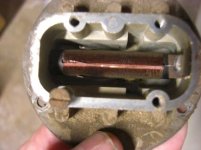So I received some information back from Moss regarding their Bugeye p/n 361-880, fuel tank sender unit. They said since Winter 2011, this p/n has been improved and uses two sliders rather than just one. Since the one in my car NOW, was purchased from them in late 2008, it is the older design.
In the interest of advancing the breed, I decided to do some research and find out how these things work. I had an old sender unit that I replaced in 2008, so I thought I would take it apart. (THIS IS NOT THE SENDER IN MY CAR TALKED ABOUT ABOVE). This is the result: This sender # Smith FT5300/32 was used with fuel guage # FG 2530/31 at least in my car (1960). When the gas tank is full, the sender reading is about 80 ohms. When the gas tank is empty, the sender reading is about 0 ohms. Which means that the fuel gauge moves to the right as the resistance of the sender increases. So if the sender wire is grounded momentarily, (0 ohms) the gauge reads empty. If the sender wire is removed, the gauge reads full (high resistance). The sender terminal is at the right in this picture. The small wire connected to the terminal in the inside is connected to the coil at the left. Here the float is dropped and indicating an <span style="font-weight: bold">empty tank </span>(low resistance). Note the sliders moved to the left, using very few windings.

 Hi Guest!
Hi Guest!

 smilie in place of the real @
smilie in place of the real @
 Pretty Please - add it to our Events forum(s) and add to the calendar! >>
Pretty Please - add it to our Events forum(s) and add to the calendar! >> 


